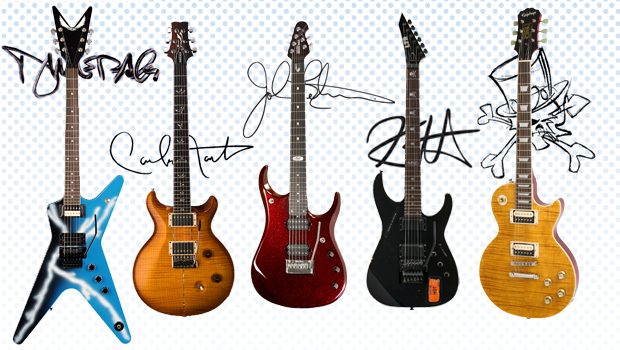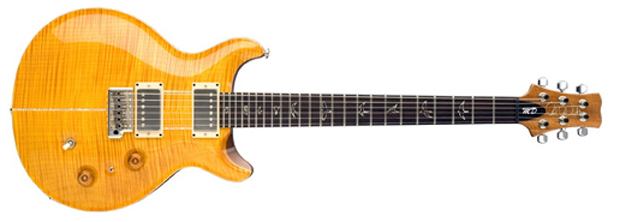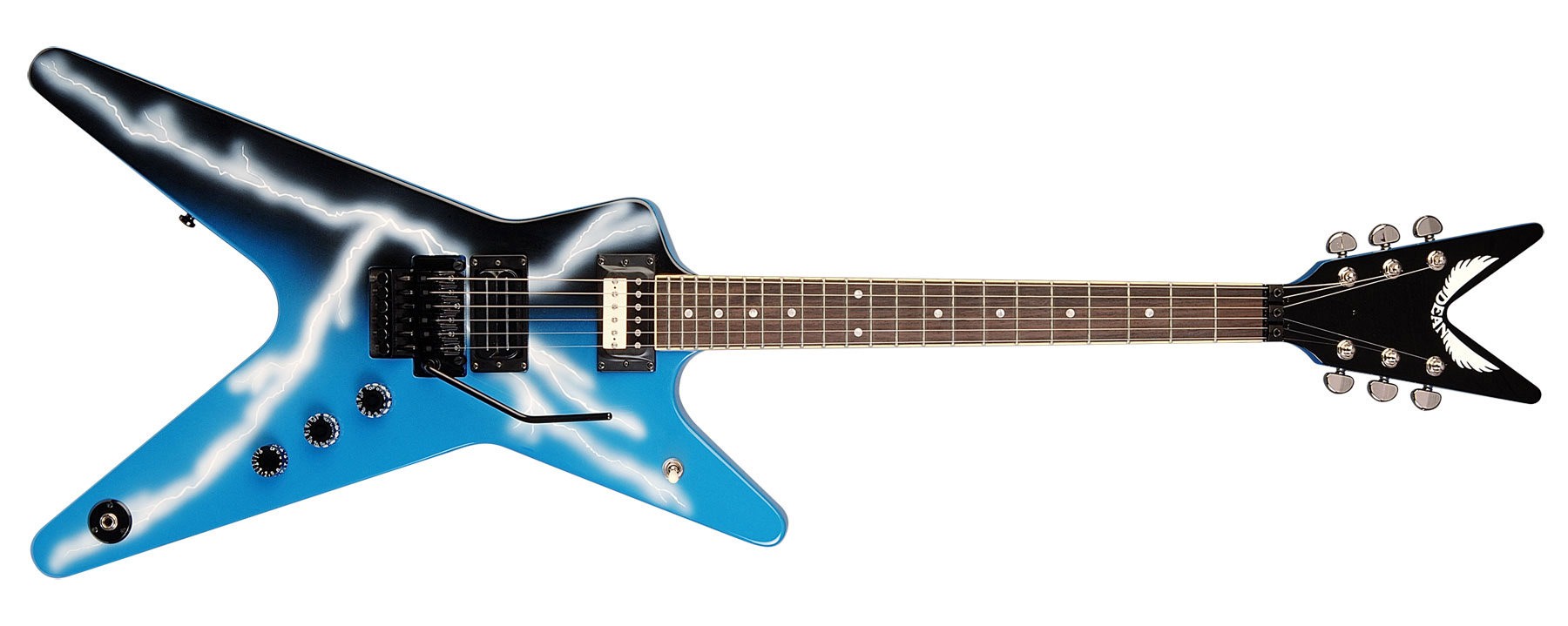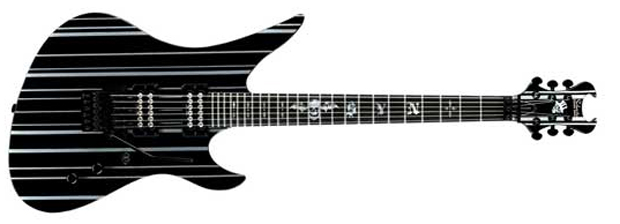Name Recognition: 10 Essential Signature Model Guitars

Ah, how young and innocent we all were when Fender introduced its first signature model — the Eric Clapton Stratocaster — in 1988.
Of course, Chet Atkins' name appeared on several Gretsch models (the Tennessean, for example) long before then, and let's not forget that Les Paul — the name that appears on millions of guitar headstocks across the world — was actually a person.
Today, new signature models seem to be popping up daily, each one "designed according to the artist's specifications." Almost every major manufacturer makes them for a host of artists from every genre of guitar-based music. This, of course, leaves players with a wealth of choices.
Below, however, is a list of 10 high-quality signature-model electric guitars that the respective artists can proudly sign their name to — 10 models that get it right.
As always, this list was compiled by a group of Guitar World editorial staffers including Technical Editor Paul Riario, the guy who tries out every piece of gear that arrives at Guitar World. The gear in this story is presented in no particular order.
Short of committing an act of grand theft Frankenstrat, the Wolfgang USA Stealth from EVH is the be-all, end-all Van Halen guitar for that moment you decide to try your hand at "Eruption."
Get The Pick Newsletter
All the latest guitar news, interviews, lessons, reviews, deals and more, direct to your inbox!
Of the guitars on this list, the Wolfgang USA Stealth features, by far, the most responsive Floyd Rose system. (It should be noted that the EVH-branded Floyd Rose isn't a floating setup, so it can only be used for diving.)
As Guitar World reviewer Chris Gill wrote in our April 2012 issue, "Whether you're a metal shredder who wants super-sonic speed and nothing-but-black aesthetics or an EVH aficionado who craves the ultimate Van Halen playing experience, the EVH Stealth delivers like no other Wolfgang.
What does it sound like?
Eddie used the EVH Wolfgang USA Stealth throughout Van Halen's North American tour this year, but in case you missed them, here's our own Paul Riario to give you a demo:
MSRP: $3,999.99 | Visit EVHGear.com to learn more about this guitar.
From its humble origins in the back of a small music store in London, Marshall Amplification has defined the sound of rock for generations of guitarists around the world. The History of Marshall Amps: The First Fifty Years by Michael Doyle and Nick Bowcott tells the story of Jim Marshall's remarkable life and documents the many innovations of Marshall amplifiers, from the famous “stack” to the most current offerings. It's available at the Guitar World Online Store.
Ibanez's Paul Gilbert model, the FRM100 (the TR often seen in the name refers to Translucent Red) takes the "signature" theme to a new level. After all, Gilbert pretty much designed this guitar himself.
"I designed the Fireman on my computer by taking a photo of an Ibanez Iceman and turning it upside-down in Adobe Photoshop," Gilbert told GuitarWorld.com in May. "Then I just worked out the extra details like adding the lower cutaway, angling the pickups, designing the pickguard shape and asking for a big, beefy neck joint. Ibanez brought the idea to life in their custom shop, and I fell in love with the guitar. The production model is killer. I used a factory sample for the whole Mr. Big tour last year."
The neck on Fireman is different than the previous RG shapes in the Gilbert signature series. It's thicker and fatter -- 22mm at the first fret and 24mm at the 12th fret. The three-piece mahogany/maple/mahogany neck offers a fat, tight sound and a solid grip. The pickups are DiMarzio Injectors in the bridge and neck and a DiMarzio Area '67 in the middle; they are designed with hum-cancelling construction to eliminate the noise but retain single-coil tone.
Other features include a mahogany body, medium frets and a Tight Tune bridge.
What does it sound like?
Here's an official Ibanez video starring Gilbert and the Fireman in action:
MSRP: $1,199.99 | Visit Ibanez.com for more info about this guitar.
ESP KH-2 Kirk Hammett Signature Model
Kirk Hammett adopted a Strat-style ESP between the recording of ...And Justice For All and the band's mega-selling self-titled album, ditching the '74 Gibson Flying V he had relied so heavily on in the band's early years. "I used that V on every album prior to this one," Hammett told Guitar World in 1991, "but the ESP just sounded a bit rounder."
At Winter NAMM 2012, ESP introduced several new models to commemorate 25 years of partnership with Metallica's lead guitarist. In those 25 years, the essential Hammett signature model has to be the KH-2, which comes in a sleek black finish or the "vintage" look, which comes complete with "Caution: Hot" and "Kirk's Guitar" stickers.
The KH-2 also features a set of EMG pickups, a Floyd Rose Original bridge and a specially contoured neck that's perfect for nimble players.
What does it sound like?
There isn't an official video demo for the KH-2, but the nice thing about signature guitars is you can point to the artists themselves as examples. In this case, pop in a copy of the Black Album and you'll hear why Kirk fell in love with these guitars.

MSRP: $3,285.00 | Visit ESPGuitars.com for more on this guitar.
This model might be at the higher end of the price spectrum as far as this list is concerned, but it truly is a work of art. The guitar, the product of a longstanding creative partnership between Paul Reed Smith and Carlos Santana, comes standard with a maple top, mahogany back, rosewood fretboard, 24-fret mahogany neck, 24 1/2-inch-scale length and PRS tremolo.
The guitar also features PRS' relatively new V12 finish, a thin, hard and clear finish that doesn't crack or react with thinners. "PRS models with this new finish feel like old instruments," said Paul Reed Smith of the finish, which is halfway between acrylic and nitro.
Other features include a carved, figured maple top; inlaid purfling strips; custom bird inlays; a bound rosewood fretboard, nickel hardware; and a rosewood headstock veneer with an inlaid eagle. The pickups are specially designed Santana Treble and Bass models.
What does it sound like?
If you have some time, check out this Musician's Friend video featuring Santana and Paul Reed Smith discussing guitar playing in general, Santana's thoughts about PRS, his signature model and other topics.
In terms of a helpful demo video, there are no videos available from PRS or Guitar World, and YouTube is particularly skimpy on the subject. Note that most of the available PRS Santana demo videos refer to the lower-priced SE model, and you can check out Paul Riario's review of the SE right here. Here's hoping PRS produces a video that explores the features of the higher-end signature model.

MSRP: $5,000 | Visit prsguitars.com for more info about this guitar.
Epiphone Limited Edition Slash Appetite Les Paul Standard
Limited to just 3,000 copies, the limited-edition Slash "Appetite" Les Paul Standard is a more-affordable alternative to the Gibson model of the same name.
Modeled after the Kris Derrig-made Les Paul copy used by Slash on Guns N' Roses' classic Appetite for the Destruction album, the Slash Appetite Les Paul comes with two Seymour Duncan Slash Alnico II Pro humbuckers, a LockTone Tune-o-matic bridge and a neck profile created especially for the mad hatter himself.
“All things considered, with the original one, it just happened to have a certain sort of unique tone unto itself,” Slash said in a video from Gibson. “The new Appetite for Destruction guitar is about as close as anybody could get to the original.”
What does it sound like?
For a look at just how this guitar performs, check out this video from Rainbow Music in Carlisle, England.

MSRP: $1,525 | Visit Epiphone.com to learn more about this guitar
Like Eddie Van Halen, Dimebag Darrell has no shortage of worthy signature models to choose from. And while you can't go wrong with any axe from Dean's ML series, we had to pick just one, and the Dean From Hell CFH model gets the nod.
Featuring a set mahogany V-neck and all-black hardware (because bad guys wear black), the Dean From Hell's lightning-bolt graphic is pure, vintage Dime, a fitting reproduction of the guitar that graces the cover of Pantera's breakout album, Cowboys From Hell.
The Dean From Hell is equipped with a Floyd Rose Special bridge and Bill Lawrence XL500 pickups, making it a high-output monster perfect for shredders of all stripes. Getcha pull!
What does it sound like?
Paired with your preferred high-gain amp, the Dean from Hell chugs, wails and squeals just like a Dime signature guitar should.

MSRP: $1,135.88 | Visit DeanGuitars.com to learn more about this guitar.
The ultra-cool Fender Jaguar never really got the widespread, mainstream appreciation it deserves; perhaps that's because of the model's supposedly confusing control layout. Get ready to throw that excuse out the window and give the Jag another shot. This new model developed by Fender for Johnny Marr (The Smiths, The Cribs, Modest Mouse) features some terrific updates.
For starters, it features a four-position blade-style pickup switch (bridge; bridge and neck in parallel; neck, bridge, and neck in series), plus two upper-horn slide switches that control pickup brightness. The pickups are custom-wound, Bare Knuckle Johnny Marr single-coil neck and bridge models. The maple neck is custom-shaped maple neck with a rosewood fingerboard that's based on Marr’s '65 Jag.
Other features include nylon bridge post inserts for improved stability, a “taller” tremolo arm with arm-sleeve nylon insert to prevent arm swing, 22 vintage-style frets; a 24-inch-scale neck, chrome hardware and a vintage-style truss rod.
Guitar World gear reviewer Chris Gill calls it "the best Jaguar that the company has ever produced" — and there's no denying this guitar looks killer in Olympic White.
What does it sound like?
Here are two videos that'll fill in the blanks about this guitar. The first one is an official Fender video featuring Marr; the second one features GW's Paul Riario.
MSRP: $4,100 | Visit fender.com for more info about this guitar.
Ernie Ball Music Man John Petrucci JP12
The latest guitar to spring from Music Man's longstanding partnership with Dream Theater's John Petrucci, the JP12 is a road-ready guitar featuring a veritable shredder's toolbox of features.
The JP-12 (which we should also mention comes in a 7-string model) comes stock with a custom John Petrucci Music Man Piezo floating tremolo. A DiMarzio Crunch Lab pickup sits in the bridge position with a DiMarzio Liquifire pickup in the neck position, giving you loads of clarity and output.
The guitar's ebony fretboard plays fast for ultra-fluid legato work and clean sweeps, making the only limitation on the JP12 how fast your hands can move while playing Chopin's Piano Concerto in A minor, Opus No. 2.
What does it sound like?
In the below video, Petrucci shows off the capabilities of his newest signature model:
MSRP: $3,500 | Visit Music-Man.com to learn more about this guitar
Gretsch G6120TV Brian Setzer Hot Rod
Gretsch makes a slew of beautiful Brian Setzer signature models, most of which are variations of a traditional 6120 Nashville. And then there's the Brian Setzer Hot Rod model, which is basically the Nashville's evil, mean twin, a guitar with a one-track mind. This is a Gretsch that's ready for rockin' right out of the box.
As Gretsch puts it, the Hot Rod is stripped down and built for speed. You get one three-position pickup switch, a single master-volume control and two TV Jones-designed Hot Rod Filter’Tron pickups that crank out some fiery tones.
Other features include a full 16-inch single-cutaway, bound, hollow body; a 1959-style trestle bracing and F holes; a two-piece rock maple neck with a bound ebony fingerboard; Sperzel locking tuners; pinned Adjusto-Matic bridge; chrome hardware and a Bigsby B6C vibrato tailpiece.
What does it sound like?
Once again, here's our own Paul Riario in a GW video from 2007:
MSRP: $3,600 | Visit gretschguitars.com for more info about this guitar.
Schecter Synyster Gates Custom
The Synyster Gates Custom is a mean-looking guitar with an original body shape, an eye-catching headstock and a cool "deathbat" inlay.
But what really makes the guitar stand out are the Seymour Duncan Custom Syn Invaders pickups, which produce the heaviest tones a passive pickup can produce. They feature three ceramic magnets, over-wound coils and 12 chrome cap screws. Sustainiac Driver/Pickup produces solid humbucker tones when the Sustain switch is off and works as the Sustainiac Driver when switched on.The Sustainiac Driver creates an infinite feedback sustain of string vibrations by electromagnetic feedback.
And then there's the ebony fretboard. According to Schecter Guitar Research, "Ebony has a snappy, crisp attack with the density of maple, but with more brittle grains, oilier pores and a stronger fundamental tone than maple. It has a tremendous amount of percussive overtones in the pick attack, that mute out shortly thereafter to foster great, long, sustain."
Other features include a mahogany body, a 25.5-inch-scale three-piece mahogany neck, 24 extra-jumbo frets, a Floyd Rose 100 Series bridge and Grover tuners. It's an axe worthy of the Avenged Sevenfold guitarist.
What does it sound like?
Although this video wasn't created by Schecter Guitar Research or Guitar World, it does an OK job of demonstrating the guitar's many features — especially if you skip to around 2:06.

MSRP: $1,649 | Visit schecterguitars.com for more info about this guitar.
“It holds its own purely as a playable guitar. It’s really cool for the traveling musician – you can bring it on a flight and it fits beneath the seat”: Why Steve Stevens put his name to a foldable guitar
“Finely tuned instruments with effortless playability and one of the best vibratos there is”: PRS Standard 24 Satin and S2 Standard 24 Satin review
![A black-and-white action shot of Sergeant Thunderhoof perform live: [from left] Mark Sayer, Dan Flitcroft, Jim Camp and Josh Gallop](https://cdn.mos.cms.futurecdn.net/am3UhJbsxAE239XRRZ8zC8.jpg)









